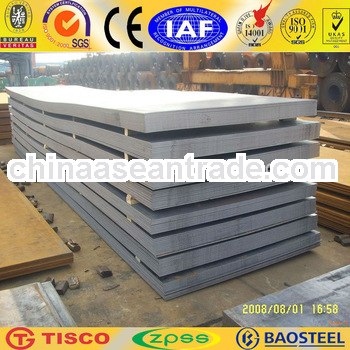310 stainless steel sheet
Specifiaction
Description | steel sheet,hot rolled steel sheet,cold rolled stainless steel sheet, steel sheet,sheet,steel plate |
Material | 201,202,304,304L,309S,310S,316,316L,316Ti,317L,321,347H,409,409L,410,410S,420,430,etc. |
Thickness | From 0.3mm to 100mm |
Width | 1000mm,1219mm,1250mm,1500mm,1800mm,2200mm or be cut as your requirement |
Length | 2000mm,2438mm,2500mm,6000mm,6096mm or be cut as your requirement |
Standard | ASME, ASTM, EN ,BS,GB,DIN, JIS etc |
Application | steel sheet applies to construction field, ships building industry, petroleum & chemical industries, war and electricity industries, food processing and medical industry, boiler heat exchanger, machinery and hardware fields. |
Packaging | Standard export sea-worthy packing |
Delivery time | 10-30 days |
Quality | No.1 |
Productivity | 1000 tons/mouth |
Note | Our company has cooperative relation between the domestic agents. Stainless steel sheet can be made accordingto the customers requirements. Fasten delivery. Quality assured. |
Contacts | If you have any question,please feel free contact me. |
Stainless steel process flow diagram
- The raw materials are first melted in an electric furnace. They are subjected to at least 12 hours of intense heat.
- The mixture is cast into either large rectangular blooms, slabs or bar-like billets, before taking on a semisolid form.
- This initial form of steel is then processed via forming operations that include hot rolling into bars, wires, sheets and slabs.
- The steel is subjected to annealing. This is a heat treatment in which the metal is first heated and then cooled under extreme, controlled conditions. The metal is thus treated for internal stresses and is duly softened and strengthened. This processing is also referred to as 'age hardening'. It requires careful monitoring of temperature and heating and cooling times. The aging temperature affects metal properties massively; while lower temperatures cause high strength and low fracture toughness (i.e., more brittle than ductile), higher temperatures result in a tougher material of lower strength (i.e., more ductile than brittle). Rapid cooling can produce a tough steel with no significant loss in strength. The heat treatment given to stainless steel depends on the type and grade of steel being produced.
- Annealing or the heat treatment can lead to the development of a precipitate, known as scale. The scale can be removed via several methods, such as pickling, (nitric-hydrofluoric acid bath), electrocleaning (application of an electric current, using phosphoric acid and a cathode), etc.
- Descalingof the material is introduced into the manufacturing process at different times, depending on the type of steel being produced. While the bar and wire forms have to be additionally treated with hot rolling, forging and extruding, the sheet and strip forms go through annealing after hot rolling.
- Cutting operations in the manufacturing process are essential in obtaining the desired shape and size of the end product. Mechanical cutting involves the use of guillotine knives and high-speed steel blades for blanking (punching out the shape by shearing) and nibbling (cutting out a series of overlapping holes). It is also cut via flame cutting, a process that involves the use of a flame generated by oxygen, propane and iron powder. The plasma jet cutting method uses an ionized gas column to melt and cut the metal.
- Surface finish, the final step in the manufacture of stainless steel, is critical to obtain the smooth and reflective surface that the metal is popular for. This last stage gives the product the desired corrosion resistance and gets the metal ready for further specific industrial manufacturing steps as required. In the surface finish stage, the metal is subjected to treatment according to the physical appearance desired: a dull finish, a bright finish or a mirror finish.
- Manufacturing end products involve further shapingvia heat-rolling, pressing, forging and extrusion. The material is then joined via welding and given the desired shape.
Application
Domestic – cutlery, sinks, saucepans, washing machine drums, microwave oven liners, razor blades
Architectural/Civil Engineering – cladding, handrails, door and window fittings, street furniture, structural sections, reinforcement bar, lighting columns, lintels, masonry supports
Transport – exhaust systems, car trim/grilles, road tankers, ship containers, ships chemical tankers, refuse vehicles
Chemical/Pharmaceutical – pressure vessels, process piping.
Oil and Gas – platform accommodation, cable trays, subsea pipelines.
Medical – Surgical instruments, surgical implants, MRI scanners.
Food and Drink – Catering equipment, brewing, distilling, food processing.
Water – Water and sewage treatment, water tubing, hot water tanks.
General – springs, fasteners (bolts, nuts and washers), wire.
Packaging and transport picture
Export standard package :bundled wooden box or be required; The inner size of container is below: 20 ft GP:5.8m(length)x 2.13m(width)x 2.18m(high) about 24-26 CBM 40 ft GP:11.8m(length)x 2.13m(width)x 2.72m(high)about 68 CBM
Transaction process




